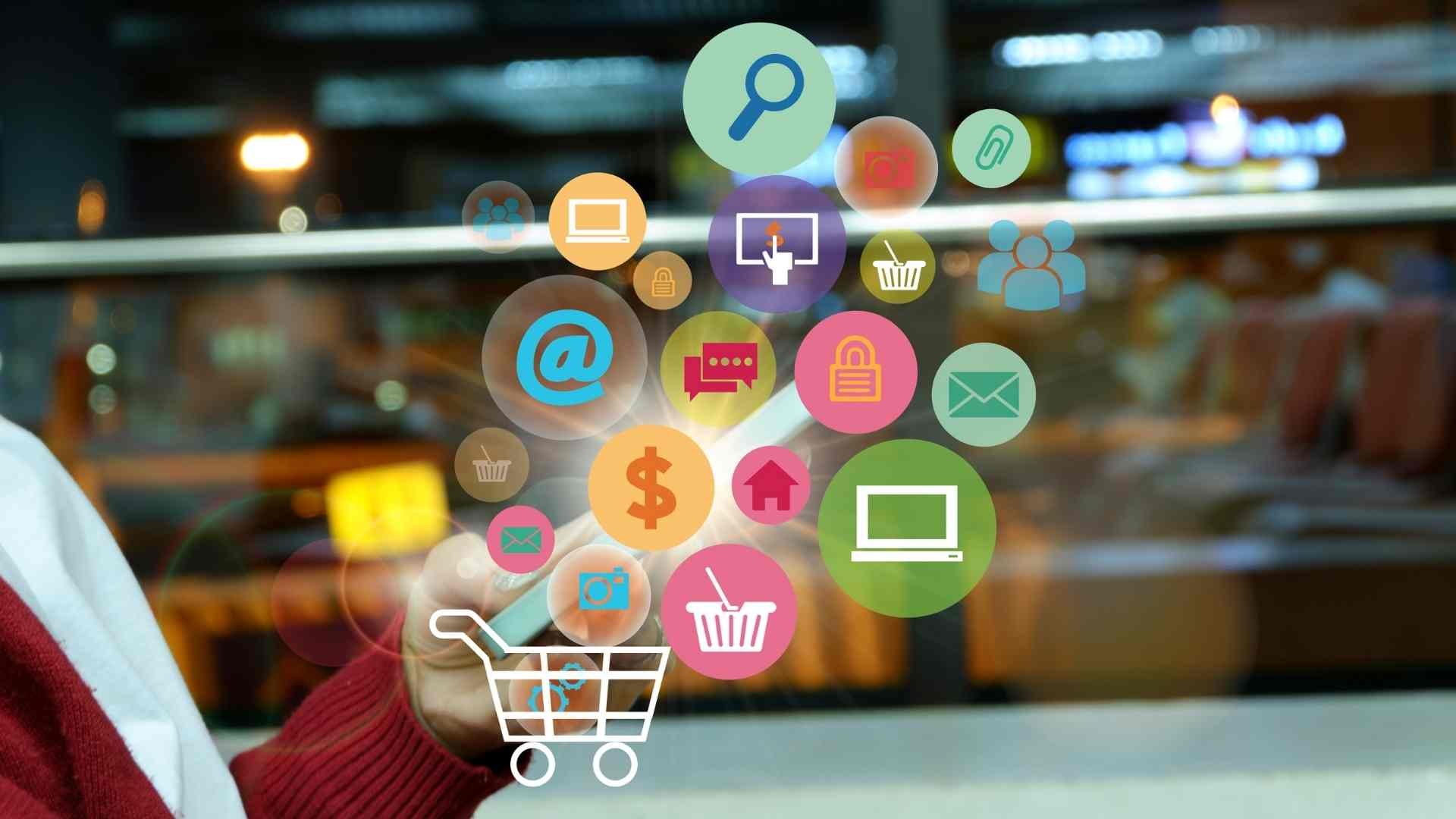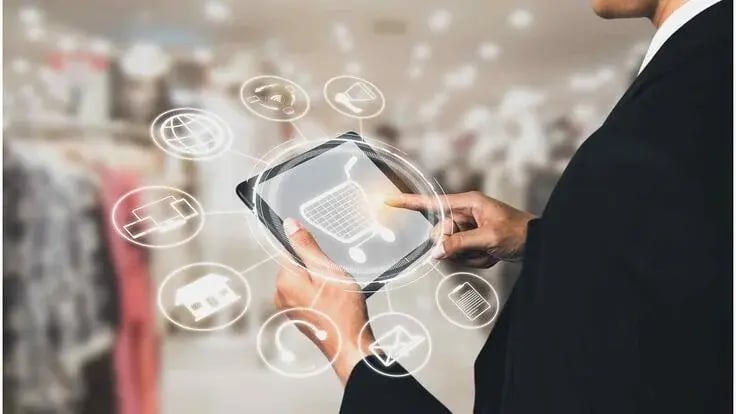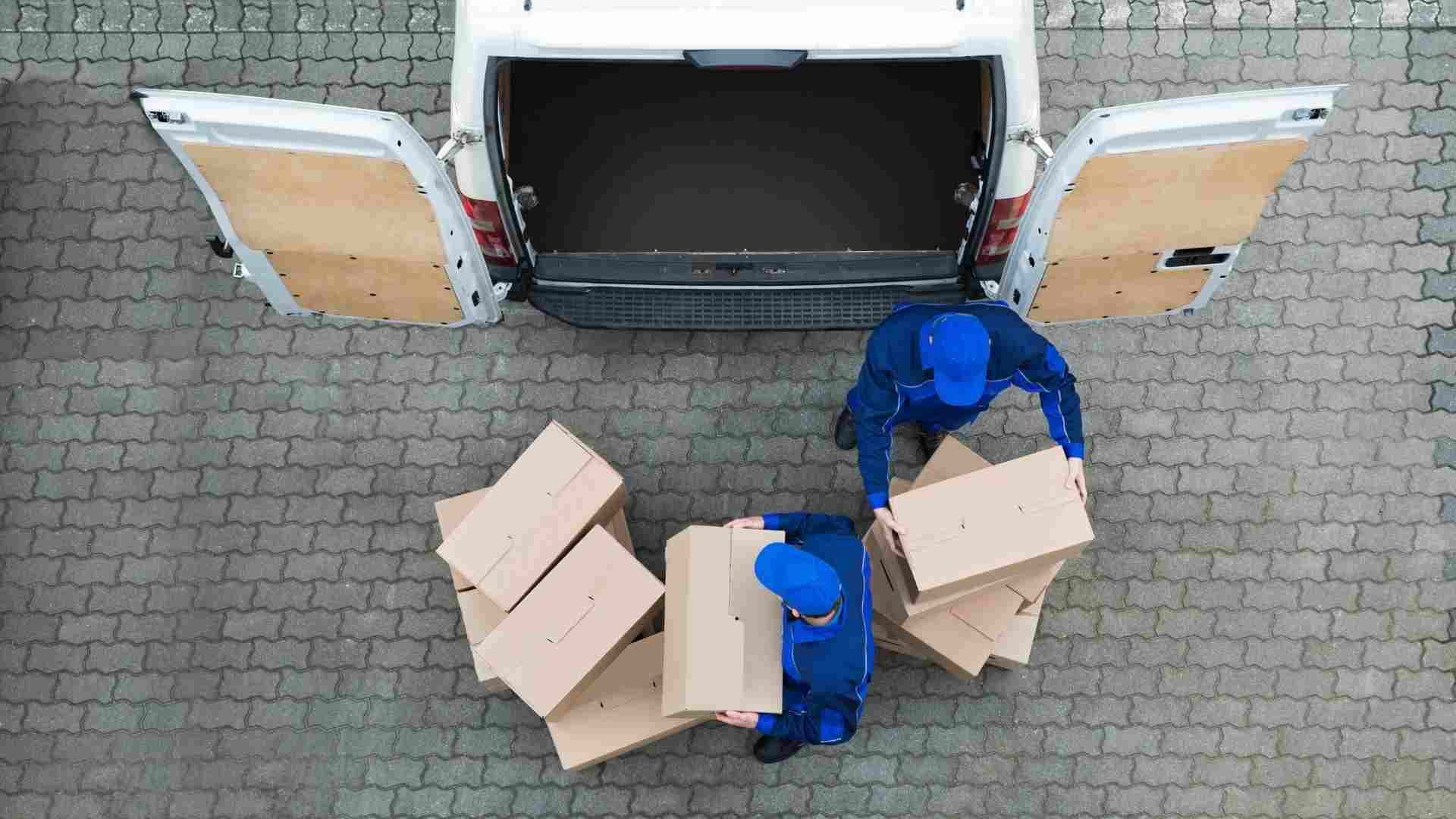Consumer buying channels have expanded and evolved, causing a ripple effect for logistics providers and partners. While the pandemic increased online retail sales 32.4% year-over-year in 2020, the rise in ecommerce has been steadily climbing for years, and in many cases grew more than expected. It isn’t just business to consumer (B2C) sales either; business to business (B2B) ecommerce has also grown as wholesalers, manufacturers, or retailers exchange products and services online. There has even been a rise in consumer to consumer (C2C) purchases as well.
As buying from online channels continues to be our “new normal,” this has meant changes for fulfillment strategies—especially third-party logistics (3PL) warehouses and ecommerce businesses. The first major change has been how to build a fulfillment strategy to meet the demands of modern commerce, wherever and however goods are sold. For many, this began with a strategy to improve warehouse operations that support ecommerce fulfillment centers.
Today, this means developing and implementing an omnichannel fulfillment strategy, and it's no surprise why this trend has become so popular over the last few years as it promotes greater satisfaction and customer loyalty. Whether you’re a small ecommerce business or an established enterprise brand, a local 3PL warehouse or node in a fourth-party logistics (4PL) network spanning the globe, a shift toward omnichannel fulfillment can deliver the sales and revenue needed to secure growth and long-term success.
But what exactly is omnichannel fulfillment? How is it different from multi-channel fulfillment? Is an omnichannel fulfillment strategy right for your business? We'll answer these questions and more in this article.
What is omnichannel fulfillment?
Omnichannel fulfillment is a strategy of having a unified approach to managing inventory and order processing from a variety of sales channels and online marketplaces. Basically, it allows businesses to streamline the fulfillment processes and distribution of orders from multiple selling channels. The key here, however, is unified.

Unlike fulfillment from a single channel, an omnichannel strategy has to allocate inventory and products from different stores and warehouses to prevent costly overstocking (or overselling).
A successful omnichannel fulfillment strategy should allow for the same inventory, order, and return processes, regardless of channel, to help businesses meet the needs of their customers more quickly and efficiently.
For this reason, it’s critical to sync omnichannel order and inventory data within a unified and comprehensive platform, so you have the inventory visibility you need to manage fluctuating stock counts and present an accurate available-to-sell to your online customers. By leveraging the right multichannel software, retailers can automate much of their store fulfillment processes—from picking to packing to shipping—while achieving tremendous agility and accuracy to wow their customers.
What’s the difference between multi-channel and omnichannel?
Though often used nearly interchangeably, multi-channel and omnichannel fulfillment are fundamentally different in some important ways. The multi-channel strategy siloes inventory based on the individual sales channel. The most common example is Fulfillment by Amazon (FBA).
While this approach may seem easier to implement at first, it can become cumbersome for businesses who may look for additional fulfillment options or returns for online purchases as time goes by and can be especially hard when expanding sales channels. Additionally, when supply chain backlogs exist, accessing one combined set of inventory may offer quicker order fulfillment versus having separately allocated inventory.
Is omnichannel fulfillment right for your business?
In the crowded and competitive world of retail, business owners are constantly looking for new ways to drive revenue, maximize capital investments, and scale up. The onset of omnichannel fulfillment services and software has revolutionized how modern selling is conducted by allowing physical stores and ecommerce teams to adapt to the growing demands of their customer base.
Omnichannel retail supports brands of all sizes in meeting consumers’ needs and provides increased inventory visibility since online shoppers can do their own research, compare prices, and buy the items from their preferred channel regardless of where the item is located.
If your business struggles to elevate the customer experience and/or ensure brand loyalty, omnichannel fulfillment may be just what you’re looking for. By integrating an omnichannel approach into your fulfillment operations, consumers can easily and seamlessly move between online channels to find what they need. Keeping up with omnichannel retail trends keeps you competitive and distinguishes your business with fulfillment strategies that align with the rapidly evolving expectations of today's customers. And when customers have a positive, memorable shopping experience with your brand, an increase in sales isn’t far behind.
Plus, if you make the shift to an omnichannel fulfillment strategy and integrate in-store inventory into digital channels, you'll open up more options for your consumers and services that bring traffic into stores and better maximize your real estate:
Buy Online, Pick-Up In-Store: Once BOPIS is enabled, curbside pick-up is an easy way to provide additional convenience to help busy moms, mobility-challenged individuals, and others shop a business while allowing your in-store sales team to suggest additional items to purchase.
Buy Online, Return In-Store: BORIS significantly cuts down on shipping costs as e-shoppers can return and exchange items without incurring additional shipping costs (for instance, buying the correct size for clothing they're returning) as well as make new purchases in person.
Reserve Online, Pick-Up In-Store: ROPIS can reduce return rates, inventory in transit, and shipping costs by allowing customers to see and/or try on products before purchasing.
Order In-Store, Ship-to-Home: This service enables your stores to save a sale when they are low on inventory, improving customer satisfaction and store conversion.
Retailers must evaluate what is important to their audience and customer experience, then select what services to offer for their business. And, you’ll find yourself in great company among retailers like Nordstrom, Ulta Beauty, PetSmart, DSW, and Dick’s Sporting Goods when you embrace omnichannel strategies.
The Benefits of Omnichannel Fulfillment
Greater Order Efficiency
Businesses are often amazed at how much easier omnichannel fulfillment becomes once they streamline all selling channels into a single, synchronized platform. This simplified system then translates to greater order efficiency, which includes more productive packing and more accurate deliveries. In addition, enhanced order management also keeps cross-channel fulfillment more consistent, so there’s less need to troubleshoot ongoing issues.
More Accurate Reporting
Another major benefit of omnichannel fulfillment is the accuracy of reporting. If you decide to implement an omnichannel model, monitoring the performance of your selling channels will be paramount to your success. But thanks to real-time reporting via omnichannel inventory management software (IMS), you can oversee all your channels in a snap. In fact, these systems offer around-the-clock reporting, meaning you can instantly check your KPIs and identify areas of improvement.
Boosted Sales & Revenue
It’s likely a bit obvious, but when you maximize your ecommerce channels and make it more convenient for consumers to buy your products, you will see a surge in online orders. If shoppers can count on you to have what they want in stock and ready to ship, they’re more apt to return to your store (rather than give their money to a competitor). So, by distributing your goods through several sales channels, you can expect to boost your revenue significantly.
Extended Brand Exposure
Customers want access to your products anytime, anywhere—which can sound like a tall order when you’re running a small business. And yet, selling on multiple websites and online platforms allows you to introduce your brand (and your product listings) to a wider range of consumers. The more visible your company is within the ecommerce landscape, the higher the chance to convert browsers into buyers, and the easier it is to acquire new customers.
Increased Consumer Satisfaction
Like it or not, modern consumers have increasingly high expectations, especially regarding product availability and home delivery service. By utilizing omnichannel fulfillment, you can maintain a much larger SKU catalog and ship goods within a much shorter window. In other words, omnichannel solutions cater to consumers’ wants and needs. And when they receive the best service (at the best price), they’ll keep returning to your store repeatedly.
Less Logistics Chaos
By unifying multiple selling channels and all order data, your fulfillment operations (both in-house and outsourced) become much more organized, streamlined, and powerful. For example, your warehouse can pick, pack, and ship from the warehouse to the consumer, a pickup location, or a store. Returns are just as easy for consumers to ship directly to the warehouse. It is the ultimate option for meeting business and consumer demands simultaneously.
The Challenges of Omnichannel Fulfillment
Maintaining Precise Inventory Counts
As great as it is, omnichannel fulfillment has its share of challenges—keeping tabs on your inventory counts being one. If you’re selling the same products on different channels, it’s tempting to double or triple count your SKUs when they’re the same item (under another listing). The good news is that a proficient inventory management system can provide real-time inventory data to ensure you don’t overstock or reorder in excess.
Implementing Safety Stock
Several variables in a store environment make it difficult for retailers to have an up-to-the-second view of in-store inventory. Customers may have items in hand or merchandise on display, or they could be lost, damaged, or, unfortunately, stolen. As a result, reducing your available-to-sell by a few units will reduce stockouts, order cancellations, and customer disappointment. Depending on the history and sales velocity, some retailers will set this across the entire chain, a region, or a specific store.
Using an Outdated Technology Infrastructure
One of the most common causes of inventory inaccuracy is operating with an outdated infrastructure; that is to say, using manual or paper-based processes to document inventory data. Not only is this practice error-prone and time-consuming, but it’s nearly impossible to keep up with when employing omnichannel fulfillment.
Utilizing technology will improve operations so you can easily process online orders from several selling channels and allow for seamless integrations to achieve order growth. This begins with a warehouse management system (WMS). You can also implement tools like barcode scanners and RFID tags to give you a clearer, more reliable picture of your inventory. Without these key technology components, businesses lack the required visibility for inventory and order management and picking, packing, and shipping using hands-free mobile barcode scanning.
Enhanced technology is your best opportunity to offer increased accuracy, optimized efficiency, and meet the needs of your customers— all with greater visibility into processes and labor.
Navigating a Segmented Supply Chain
When dealing with omnichannel logistics, companies must know the status of their inventory, whether it’s sitting in a fulfillment center or en route to the customer. This becomes an even greater challenge during peak season, when distribution centers are typically at their busiest. To navigate a dispersed supply chain with skill and ease, businesses need to implement an order management system (OMS) that can guarantee each segment runs smoothly.
Setting Order Routing Rules
Before retailers enable their in-store inventory online, they must determine how their omnichannel software will assign orders to a store. Will orders be routed to ship from the store closest to the customer? From the store that can complete the order in one shipment? Or from the store that is assigned as a priority fulfillment location? Creating a prioritized list of omnichannel fulfillment rules is essential to minimizing shipping costs and ensuring profitability.
How to Get Started with Omnichannel Fulfillment
Even if you understand the benefits of omnichannel fulfillment—and recognize what it takes to bypass its challenges—you may still be wondering how to get started with this process.
Many brands like to take a hybrid approach to omnichannel transformation, meaning they fulfill certain orders in-house but team up with other fulfillment companies (like 3PL warehouses) for specific selling channels. A practical example of this comes from FBA; Amazon has strict requirements for Prime shipping but also works with a 3PL and fulfills other non-Amazon orders themselves.
Perhaps the most important thing to consider before your company transitions to an omnichannel format is which software solutions to adopt that will allow you to consolidate various channels for the most cohesive, streamlined fulfillment possible.

Specifically, you’ll want a fulfillment technology stack—including some combination of an inventory, warehousing, and order management system—to automate and customize your processes.
If you’ll be outsourcing fulfillment to a logistics provider, be sure they offer integrations with your preferred inventory software and the ecommerce platforms or online marketplaces where you plan on selling.
Improve Your Omnichannel Fulfillment Strategy with Extensiv
Extensiv remains a leader in inventory management and omnichannel fulfillment by focusing on improving the way you processes and manage customer orders and inventory across all ecommerce sales channels. Extensiv is a pivotal player in fulfillment optimization, ensuring orders arrive on time and at the lowest possible cost.
This system simplifies stock replenishment by creating a central platform with a single viewpoint into your inventory items. With Extensiv's Order Management solution, businesses can trust that current and future consumer demand is met while also balancing the need for improved budget control and back-office logistics. This software automates several necessary functions to unify your segmented supply chain: order routing, order splitting, bundling and kitting, inventory forecasting, and reordering (via automated purchase orders).
Additionally, Extensiv Integration Manager synchronizes all inventory and order data across systems, including those used by logistics partners, like Extensiv 3PL Warehouse Manager, for outsourced fulfillment operations.
Interested in how Extensiv can help your company join the omnichannel trend? Request a free demo today!
-
You’ll read about:
Be the first to know
Subscribe to our newsletter








